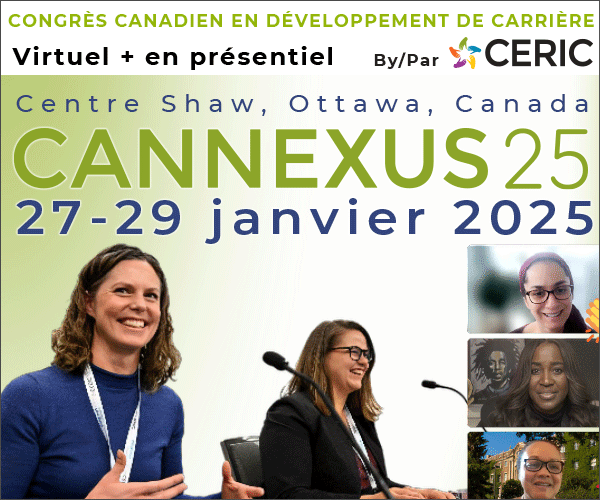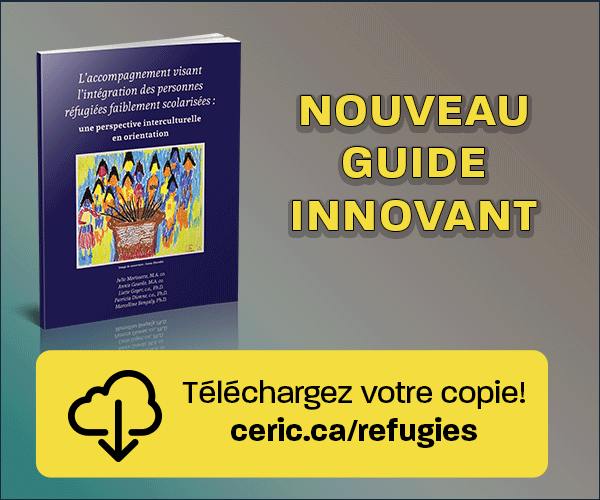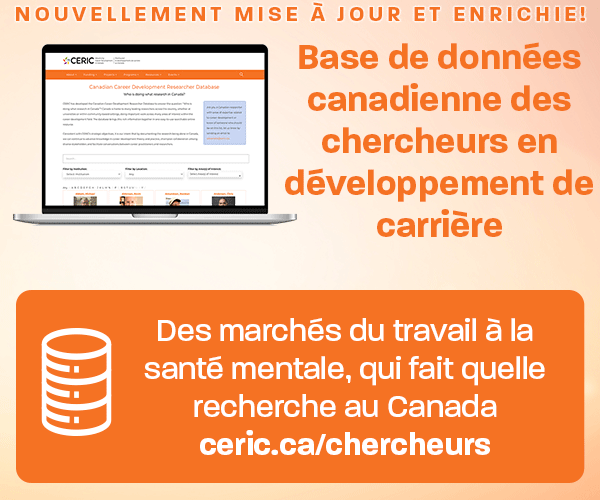L'effet de l'espoir sur l'engagement des étudiants, leur performance académique et leur identité professionnelle
Mots-clés :
participation des étudiants, rendement scolaire, identité professionnelle, espoir, Canada, États-Unis d'Amérique, étudiantsRésumé
Cette étude porte sur la mesure de référence du répertoire des carrières axées sur l’espoir (HCCI/RCAE) au Canada et aux États-Unis et sur le lien qu’il peut exister entre espoir, engagement des élèves, résultats académiques et identité professionnelle, avec l’espoir comme principal indicateur. L’échantillon se composait de 1685 étudiants issus de deux universités au Canada et de deux universités aux États-Unis. On a ainsi pu déterminer à partir des données rassemblées, des scores normatifs du HCCI/RCAE concernant les étudiants canadiens et américains. Les résultats révèlent que l’espoir a un impact à la fois sur l’identité professionnelle et la performance académique (moyenne pondérée cumulative des notes/MPC) et se manifeste par un facteur décisif, l’engagement des étudiants. Il a en revanche été établi que l’espoir influait faiblement sur la moyenne. L’engagement des étudiants, quant à lui a un impact direct sur le rapport à la moyenne des notes et un impact relatif sur le rapport à l’identité professionnelle.
Références
Appleton, J. J., Christenson, S. L., & Furlong, M. J. (2008). Student engagement with school: Critical conceptual and methodological issues of the construct. Psychology in the Schools, 45, 369–386. doi:10.1002/pits.20303
Angell, L. R. (2009). Construct validity of the community college survey of student engagement IS (CCSSE). Community College Journal of Research and Practice, 33(7), 564–570. doi:10.1080/10668920801901217
Avey, J. B., Patera, J. L., & West, B. J. (2006). The implications of positive psychological capital on employee absenteeism. Journal of Leadership and Organizational Studies, 13(2) 42-60. doi: 10.1177/10717919070130020401
Bandura, A. (2001). Social cognitive theory: An agentic perspective. Annual Review of Psychology, 52, 1–26. doi:10.1146/ annurev.psych.52.1.1
Bentler, P. M. (1990). Comparative it indexes in structural models. Psychological Bulletin, 107, 238-246. doi:10.1037/0033-2909.107.2.238
Browne, M.W., & Cudeck, R. (1993). Alternative ways of assessing model fit. In K.A. Bollen & J.S. Long (Eds.) Testing structural equation models (pp. 136-162). Newbury Park, CA: Sage.
Carini, R. M., Kuh, G. D., & Klein, S. P. (2006). Student engagement and student learning: Testing the linkages. Research in Higher Education, 47(1), 1–32. doi:10.1007/s11162-005-8150-9
Combs, G. M., Clapp-Smith, R., & Nadkarni, S. (2010). Managing BPO service workers in India: Examining hope on performance outcomes. Human Resource Management, 49(3), 457– 476. doi:10.1002/hrm.20355
Curry, L. A., Snyder, C. R., Cook, D. L., Ruby, B. C., & Rehm, M. (1997). Role of hope in academic and sport achievement. Journal of Personality and Social Psychology, 73, 1257–1267. doi:10.1037/0022-3514.73.6.1257
Day, L., Hanson, K., Maltby, J., Proctor, C., & Wood, A. (2010). Hope uniquely predicts objective academic achievement above intelligence, personality, and previous academic achievement. Journal of Research in Personality, 44(4), 550-553. doi: 10.1016/j.jrp.2010.05.009
Fredricks, J. A., Blumenfeld, P. C., & Paris, A. H. (2004). School engagement: potential of the concept, state of the evidence. Review of Educational Research, 74(1), 59 –109. doi:10.3102/00346543074001059
Gushue, G. V., Scanlan, K. R. L., Pantzer, K. M., & Clarke, C. P. (2006). The relationship among support, ethnic identity, career decision self-efficacy, and outcome expectations in African American high school students applying social cognitive career theory. Journal of Career Development, 33(2), 112-124. doi:10.1177/0894845306293416.
Hall, D. T. (1996). Protean careers of the 21st century. The Academy of Management Executive, 10(4), 8–16. doi:10.5465/AME.1996.3145
Holland, J. L., Daiger, D., & Power, P.G. (1980). My vocational situation: Description of an experimental diagnostic from for the selection of vocational assistance. Palo Alto, CA: Consulting Psychologists Press.
Holland, J. L., Johnston, J. A., & Asama, N. F. (1993). The Vocational Identity Scale: A diagnostic and treatment tool. Journal of Career Assessment, 1, 1-12. doi: 10.1177/106907279300100102
Hooper, D., Coughlan, J., & Mullen, M.R. (2008). Structural equation modelling: Guidelines for determining model fit. Electronic Journal of Business Research Methods, 6(1), 53-60.
Hu, L. T., & Bentler, P. M. (1999). Cutoff criteria for fit indexes in covariance structure analysis: conventional criteria versus new alternatives. Structural Equation
Modeling, 6, 1-55. doi:10.10 80/10705519909540118
Jackson, C. C., & Neville, H. A. (1998). Influence of racial identity attitudes on African American college students’ vocational identity and hope. Journal of Vocational Behavior, 53, 97- 113. doi:10.10 06/jvbe.1997.1611
Juntunen, C. L., & Wettersten, K. B. (2006). Work hope: Development and initial validation of a measure. Journal of Counseling Psychology, 53(1), 94-106. doi:10.1037/0022-0167.53.1.94
Gordon, J., Ludlum, J., & Hoey, J. J. (2007). Validating NSSE Against student outcomes: Are they related? Research in Higher Education, 49(1), 19–39. doi:10.1007/s11162-007-9061-8
Kishton, J. M., & Widaman, K. F. (1994). Unidimensional versus domain representative parceling of questionnaire items: An empirical example. Educational and Psychological Measurement, 54, 757–765. doi:10.1177/0013164494054003022
Kuh, G. D. (2003). What we’re learning about student engagement from NSSE: Benchmarks for effective educational practices. Change: The Magazine of Higher Learning, 35(2), 24-32. doi:10.1080/00091380309604090
Landis, R. S., Beal, D. J., & Tesluk, P.E. (2000). A comparison of approaches to forming composite measures in structural equation models. Organizational Research Methods, 3, 186–207. doi:10.1177/109442810032003
Little, T. D., Cunningham, W. A., Shahar, G., & Widaman, K. F. (2002). To parcel or not to parcel: Exploring the question, weighing the merits. Structural Equation Modeling: A Multidisciplinary Journal, 9, 151–173. doi:10.1207/S15328007SEM0902_1
Luthans, F., Avolio, B. J., Avey, J. B., & Norman, S. M. (2007). Positive psychological capital: Measurement and relationship with performance and satisfaction. Personnel Psychology, 60, 541–572. doi:10.1111/j.1744-6570.2007.00083.x
Luthans, F., Avolio, B. J., Walumbwa, F. O., & Li, W. (2005). The psychological capital of Chinese workers: Exploring the relationship with performance. Management and Organization Review, 1, 247-269. doi:10.1111/j.1740-8784.2005.00011.x
MacKinnon, D. P., Lockwood, C. M., Hoffman, J. M., West, S. G. & Sheets, V. (2002). A comparison of methods to test mediation and other intervening variable effects. Psychological Methods, 7(1), 83-104. doi:10.1037/1082-989X.7.1.83
National Research Council & Institute of Medicine. (2004). Engaging schools fostering high school students’ motivation to learn. Washington, D.C.: National Academies Press. Retrieved from http://site.ebrary.com/id/10049194
Niles, S. G., Amundson, N. E., & Neault, R. (2011). Career flow: A hope-centered approach to career development. Boston, MA: Pearson.
Niles, S. G., In, H., Chen, F., Su, N., deShield, S., & Yoon, H. J. (2013). Elevating hope in career development theory and practice. Manuscript submitted for publication.
Niles, S. G., Yoon, H. J., Amundson, N. E., (2010). The Hope-Centered Career Inventory [Online Assessment]. Available from http://mycareerflow.com
Niles, S. G., Yoon, H. J., Balin, E., Amundson, N. E., (2010). Using a hope-centered model of career development in challenging times. Turkish Psychological Counseling & Guidance Journal, 4(34), 101-108.
Osipow, S. H., Carney, C. G., & Barak, A. (1976). A scale of educational-vocational undecidedness: A typological approach. Journal of Vocational Behavior, 9, 233–243. doi:10.1016/0001-8791(76)90081-6
Peterson, S. J. & Byron, K. (2008). Exploring the role of hope in job performance: Results from four studies. Journal of Organizational Behavior, 29, 785-803. doi:10.1002/job.492
Perry, J. C., Liu, X., & Pabian, Y. (2009). School engagement as a mediator of academic performance among urban youth: the role of career preparation, parental career support, and teacher support. The Counseling Psychologist, 38, 269–295. doi:10.1177/0011000009349272
Porter, S. R. (2011). Do college student surveys have any validity? The Review of Higher Education, 35, 45–76. doi:10.1353/rhe.2011.0034
Rand, K. L. (2009). Hope and optimism: Latent structures and influences on grade expectancy and academic performance. Journal of Personality, 77, 231- 260. doi: 10.1111/j.14676494.2008.00544.x
Robitschek, C., & Cook, S. W. (1999). The Influence of Personal Growth Initiative and Coping Styles on Career Exploration and Vocational Identity. Journal of Vocational Behavior, 54(1), 127-141. doi:10.1006/jvbe.1998.1650
Saks, A. M. (2006). Antecedents and consequences of employee engagement. Journal of Managerial Psychology, 21, 600–619. doi:10.1108/02683940610690169
Saenz, V. B., Hatch, D., Bukoski, B. E., Kim, S., Lee, K., & Valdez, P. (2011). Community college student engagement patterns: A typology revealed through exploratory cluster analysis. Community College Review, 39, 235–267. doi: 10.1177/0091552111416643
Scott, A. B., & Ciani, K. D. (2008). Effects of an undergraduate career class on men’s and women’s career decision-making self-efficacy and vocational identity. Journal of Career Development, 34(3), 263-285. doi:10.1177/0894845307311248
Seirup H. & Rose S. (2011). Exploring the effects of hope on GPA and retention among college undergraduate students on academic probation. Education Research International, 2011, 1- 7. doi:10.1155/2011/381429
Sung, Y., Turner, S. L., & Kaewchinda, M. (2012). Carter development skills, outcomes, and hope among college students. Journal of Career Development. Advanced online publication. doi:10.1177/0894845311431939
Synder, C. R. (2002). Hope theory: Rainbows in the mind. Psychological Inquiry, 13, 249-275. doi: 10.1207S1532 7965PLI1304_01.
Snyder, C. R., Harris, C., Anderson, J. R., Holleran, S. A., Irving, L. M., Sigmon, S. T., & Harney, P, (1991). The will and the ways: Development and validation of
an individual-differences measure of hope. Journal of Personality and Social Psychology, 60, 570–585. doi: 10.1037/00223514.60.4.570
Snyder, C.R., Irving, L.M., & Anderson J. (1991). Hope and health. In C. R. Snyder & D. R. Forsyth (Eds.), Handbook of Social and Clinical Psychology (pp. 285–305). Elmsford, NY: Pergamon Press.
Snyder, C. R., Shorey, H. S., Cheavens, J., Pulvers, K. M., Adams III, V. H., & Wiklund, C. (2002). Hope and academic success in college. Journal of Educational Psychology, 94, 820–826. doi:10.1037/0022-0663.94.4.820
Tombaugh, J. R., Mayfield, C. O., & Wooten, K. C. (2011). Examining the affective and temporal dimensions of the positive affect-work attitude relationships: The mediating role of hope. The Journal of Applied Management and Entrepreneurship, 16(2), 25-41
Tucker, L. R., & Lewis, C. (1973). A reliability coefficient for maximum likelihood factor analysis. Psychometrika, 38, 1-10. doi:10.1007/BF02291170
Van Ryzin, M. J. (2011). Protective factors at school: Reciprocal effects among adolescents’ perceptions of the school environment, engagement in learning, and hope. Journal of Youth and Adolescence, 40(12), 1568-1580. doi:10.1007/s10964-011-9637-7
Yoon, H. J. (2011). The development and validation of the assessment of human agency employing Albert Bandura’s human agency theory. Unpublished doctoral dissertation, The Pennsylvania State University, University Park.
Youssef, C. M. & Luthans, F. (2007). Positive organizational behavior in the workplace: The impact of hope, optimism, and resilience. Journal of Management, 33(5), 774-800. doi: 10.1177/0149206307305562
Wanberg, C. R., & Muchinsky, P. M. (1992). A typology of career decision status: Validity extension of the vocational decision status model. Journal of Counseling
Psychology, 39, 71–80. doi: 10.1037/0022-0167.39.1.71
Wandeler, C. A. & Bundick, M. J. (2011). Hope and self-determination of young adults in the workplace. The Journal of Positive Psychology, 6 (5), p. 341. doi:10.1080/17439760.2011.584547

Téléchargements
Publié-e
Comment citer
Numéro
Rubrique
Licence

Cette œuvre est sous licence Creative Commons Attribution - Pas d'Utilisation Commerciale - Pas de Modification 4.0 International.











